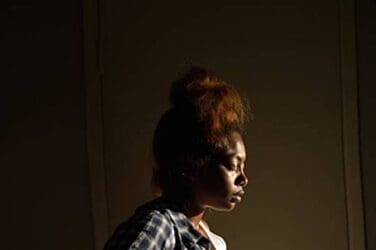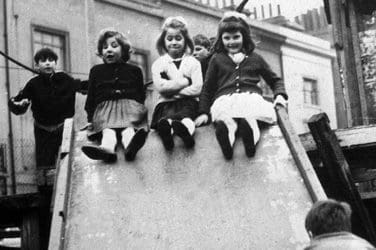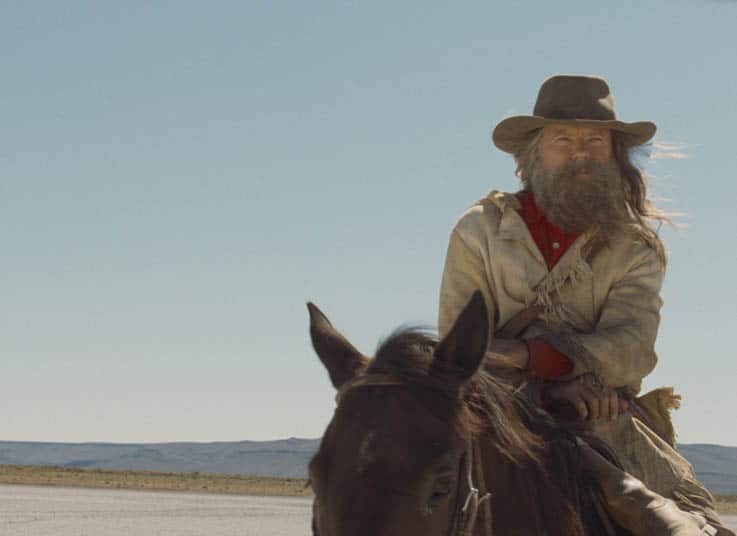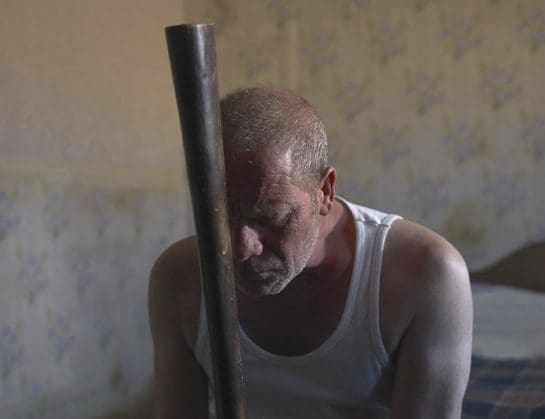words Caroline Young
To celebrate the sixtieth anniversary of the release of What Ever Happened to Baby Jane?, Robert Aldrich’s camp horror classic starring Bette Davis and Joan Crawford, Caroline Young explores the film’s legacy in an extract from her book, Crazy Old Ladies: The Story of Hag Horror.
Joan Crawford made her entrance on stage wielding an axe.
In January 1964, at the age of fifty-eight, the Hollywood grande dame began an exhaustive tour across the United States, with personal appearances at big city and small town cinemas to publicize her new horror film, Strait-Jacket, directed by B-movie master William Castle.
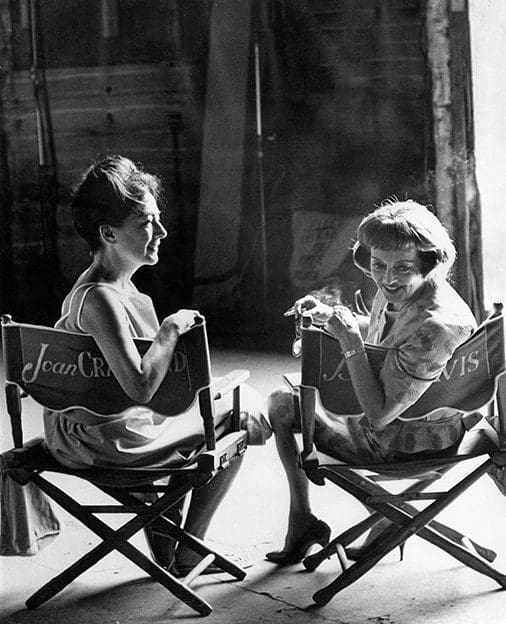
Because she sat on the board for Pepsi-Cola, she was able to travel across the country on the luxury Pepsi jet, with Columbia Pictures distributing a list of her requirements for each stop. These included a bedroom each for her publicist, her maid Anna Brinke, known as “Mamacita,” and the two pilots; and a rider including pens, pencils and paper, red and yellow roses, one bowl of peppermint lifesavers, several buckets of cracked ice, 100 proof Smirnoff vodka, Beefeater gin, Moët and Chandon champagne, and a case of Pepsi-Cola. As the list of instructions made clear, “Miss Crawford is a star in every sense of the word; and everyone knows she is a star.”
The tour kicked off in New York, traveling to three theaters a night for seven days across Manhattan, Brooklyn, the Bronx, Queens and Staten Island. The first stop was Loews cinema in the Bronx, and William Castle remembered: “As the bus pulled up in front of the theater and Joan Crawford, magnificently dressed, stepped down, there was a roar. The crowd went wild…Joan threw kisses to the crowd, thanked them for coming, and then disappeared backstage. The theater was sold out for the six o’clock show.”
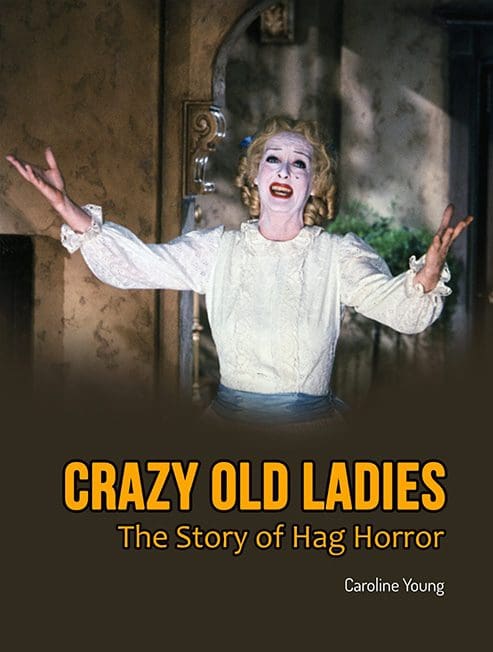
To introduce the movie, Crawford appeared on stage with a cardboard axe, and this moment of pure camp thrilled the young audience, many of whom hadn’t been born when she was starring in The Women in 1939, or even when she won her Academy Award for Mildred Pierce in 1946. When the screening began, they might not have understood the significance of her entrance in Strait-Jacket, doing the Joan Crawford walk, where her broad shoulders become their own character. They may have howled with laughter at the over-the-top moments of horror, with fake heads being lopped off and rolling on the ground, or when, as a woman in her sixties, she seduces her daughter’s boyfriend by teasing her fingers into his mouth. Yet Crawford was utterly convincing in the over-the-top role and despite being widely panned by critics, audiences embraced the film.
“Joan Crawford has picked some lemons, some very sour lemons, in her day, but nigh the worst of the lot is Strait-Jacket, in which she showed up at neighborhood theaters yesterday,” wrote The New York Times’ Bosley Crowther in January 1964. But the film’s success affirmed Crawford’s reinvention as a horror queen.
Strait-Jacket was one of a new breed of horror movies that exposed a big name star to thrills and shocks, and which would later be referred to as “Hag Horror,” “Hagsploitation,” “Psycho-biddy” or “Grande Dame Guignol.” It was a sub-genre launched on the back of 1962’s What Ever Happened to Baby Jane?, the hugely-successfulgothic horror starring Crawford and her long-standing rival Bette Davis, whose decades-long feud had become the stuff of legend. It was also the rare film that demonstrated that two older women could headline a successful movie, and triggered a trend for other older actresses to ham it up in horror, while cashing the often-generous check.
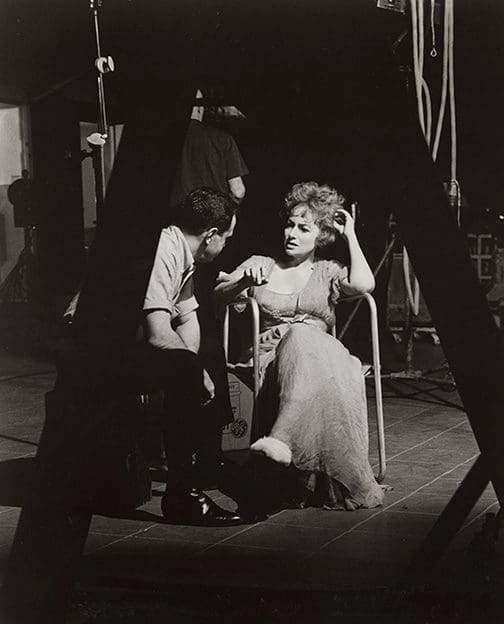
“Of course she rationalized what she did,” said director George Cukor. “Joan even lied to herself. She would write to me about these pictures, actually believing that they were quality scripts. You could never tell her they were garbage. She was a star, and this was her next picture. She had to keep working, as did Bette.”
As a way to boost their flagging careers, silver screen beauties like Gloria Grahame, Ann Sothern, Tallulah Bankhead, Miriam Hopkins, Veronica Lake, Barbara Stanwyck, Lana Turner, Yvonne De Carlo and Ruth Roman all took up the horror mantle to varying degrees of success. The characters they played were typically once-glamorous women preoccupied with their past and unable to move on. The films often showed old clips and real life glamor shots of the actresses from their glory days, which their character displays in their home; a knowing reference first used in Sunset Boulevard (1950), where Gloria Swanson’s younger glamor shots and film clips stood in for her character Norma Desmond. Similarly, in Die! Die! My Darling! (1965) Tallulah Bankhead lent real life portraits of herself from her twenties to be used for a scrapbook belonging to her character, Mrs Trefoile.
For women, youth has always been entwined with beauty, and as actresses got older, they were considered to now be lacking some of that original appeal. Even a bombshell like Marilyn Monroe began to worry she would become less relevant as she reached her mid-30s. For actresses, the fear of aging was not just for vanity; it was deep-rooted in their career. They would lose out on lead roles in quality scripts and would instead be relegated to the spinster, the matron or the tragic, desperate older woman. If she’d lived, Monroe would likely have been considered the past-it sex-pot, ridiculed and pitied as if she was desperately trying to cling to her looks.
Myrna Loy, star of MGM’s hugely popular The Thin Man in 1934, found out for herself that older actresses were treated badly by Hollywood. “The studio no longer cared about us,” she said. “They kept us locked into our old images while they concentrated on giving the good roles to newcomers. If we complained they had ways of forcing us out, of making us quit.” But she also wondered if exploitative horror films were detrimental to these stars, particularly Bette Davis. “Is it worth playing all those demented old ladies to maintain that status?”
Rather than continuing to play romantic leads, older, unmarried women on screen were typically shown to be pathetic figures or mentally unstable, driven mad by their single status and their lost looks, and it was this trope that formed the basis of “Hag Horror.”
Melodrama, gothic horror, stylized death scenes and a faded star slipping into mental deterioration were the defining markers of the genre. They were what critic Roger Ebert in 1971 referred to as “the macabre genre of the menopausal metaphysical mystery movie.” He described how they “seem to involve a couple of middle-aged ladies with shameful pasts, who make lots of trips up and down dark stairs and into unlighted cellars, get the hell scared out of them when dust mops fall out of the shadows, and end up hideously, with blood and feathers all over the place. Well, it’s a way to pass an evening.”
The titles of these films were also a literal description of the troubled, reclusive woman at the center of the story – there was What Ever Happened to Aunt Alice? (1969), What’s the Matter with Helen? (1971), and Whoever Slew Auntie Roo? (1971). Even Hush, Hush Sweet Charlotte (1964), director Robert Aldrich’s follow up to Baby Jane, was originally to be called What Ever Happened to Cousin Charlotte?
John Baxter in Hollywood in the Sixties described “Hag Horror” as celebrating “sado-gerontophilia,” which insultingly implied that a woman over fifty couldn’t be considered a viable sex symbol. The women in “Hag Horror” are spinsters, recluses and alcoholics, and tend to have a limited, or non-existent, sex life, which perhaps leads to their frustration. In What Ever Happened to Baby Jane? two unmarried sisters are forced to live together despite their hatred for one another, due to their rejection of societal norms.
The older woman often exhibits unstable behavior because of a trauma of the past, typically the result of the loss of a child, or because they missed their chance of having a family due to the abandonment, or death, of a lover. They’ve either rejected the proper gender roles of being a good wife and mother, in favor of their unnatural desires, as in Strait-Jacket, or perhaps their child has died, as experienced by Mrs Trefoile in Die! Die! My Darling.
Sometimes their domineering maternal instincts, or their neglect through being a single mother with different lovers, prevents their child from being able to function normally in society. The mothers in Strait-Jacket (1964), Berserk! (1967) and The Killing Kind (1973) are blamed for their children being murderers, due to their atypical behavior outside the realm of what a “normal” mother should be like.
As the feminist movement gained ground in the sixties, and women were being given agency over their reproduction rights with the advent of the pill, the concept of the independent woman was becoming a threat to patriarchy. The fifties had pushed family values to the fore, supported by a conservative sway in Hollywood which used female tropes to demonstrate to women that marriage was the only way to have a fulfilling life. By depicting older women in horror films who were mentally disturbed and scarred by the lost opportunities in life, they served as a warning to others – that this is how you’ll turn out if you don’t perform your assigned gender roles.
While these “Hag Horror” films, of mixed quality, were seen to be a low career point, many of the actresses enjoyed showcasing their acting skills to play complex, twisted characters. After all, it could be fun to camp it up, wield an axe and drag a dead body. “Hag Horror” was successful on two points – it appealed to the nostalgia of older moviegoers who wished to relive their youth by seeing their favorite icons on screen, and for younger horror audiences who watched these aging stars with a degree of irony. What could be more appealing than seeing these former A-list stars, who had only appeared in heavily-censured films of the past, now being tortured on screen or wielding sharp objects?















